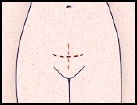Pelvic Organ Prolapse: Surgery for Vaginal Vault Prolapse
Pelvic Organ Prolapse: Surgery for Vaginal Vault Prolapse

Vaginal vault prolapse is when the vagina loses its support and drops toward the opening and sometimes beyond the opening. This can happen after the uterus has been removed. The goal of surgery is to fix the problem and relieve your symptoms.

The surgical procedure
A vaginal vault suspension may be used to correct vaginal vault prolapse. This type of surgery can be done through the vagina or the abdomen. The vagina is attached to strong tissue in the pelvis or to the sacrum. This is a bone at the base of the spine that forms the back of the pelvis.
Possible risks and complications of surgery
-
Infection
-
Bleeding
-
Risks of anesthesia
-
Damage to nerves, muscles, or nearby pelvic structures
-
Blood clots
-
Prolapse of the pelvic organ or organs occurring again
Your incisions
During surgery, the doctor reaches your pelvic organs through the vagina or the abdomen. An incision may be made in the vaginal wall. If surgery through the abdomen is done, the doctor makes multiple small incisions to insert laparoscopic instruments or one larger incision that is either up and down (vertical) or across (transverse).


Updated:
March 15, 2019
Sources:
Pelvic Organ Prolapse in Women: Choosing a primary surgical procedure. UpToDate., Pelvic Organ Prolapse in Women: Surgical Repair of Apical Prolapse (Uterine or Vaginal Vault Prolapse). UpToDate.
Reviewed By:
Goode, Paula, RN, BSN, MSN,Sacks, Daniel, MD, FACOG